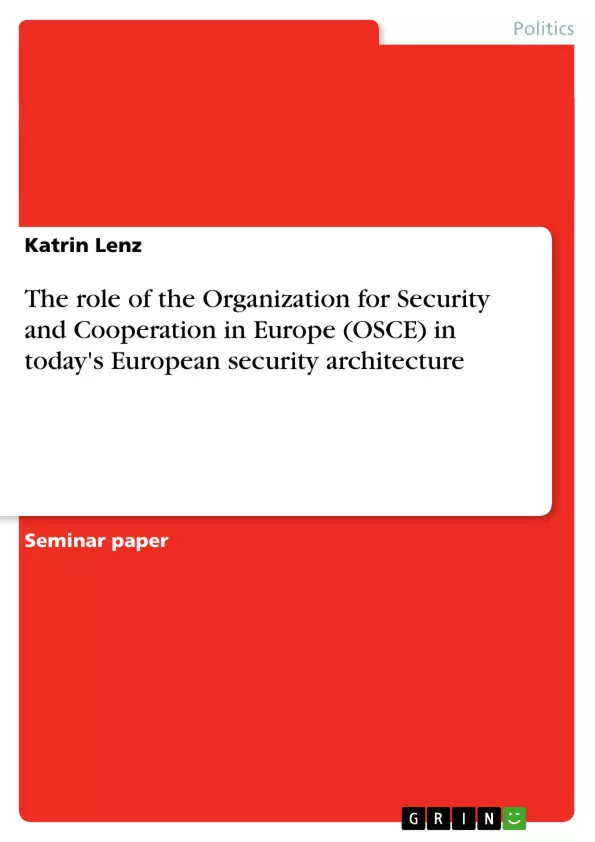The idea of seeking security through an international organization is certainly not new. Immanuel Kant envisaged it already over two centuries ago in Idea for a Universal History from a Cosmopolitan Point of View (1784). “Through war, through the taxing and never-ending accumulation of armament… after devastations, revolutions, and even complete exhaustion,”Kant foresaw that“human nature would bring people to that wh ich reason could have told them in the beginning: that humankind must step from the lawless condition of savages into a league of nations to secure the peace.”
The Concert of Europe, the League of Nations, and the UN were all built upon the principle of preserving peace. One can argue about their successes and failures, but the UN is now more than fifty years old and is still an important player in the global security architecture through for instance its peacekeeping operations. The UN Charter states in Article 1 that all members shall be committed “tomaintain international peace and security, and to that end, to take effective collective measures”to preserve or restore the peace and Article 24 provides the Security Council with the “primary responsibility for the maintenance of international peace and security.” The concept of “collective security” was a principle of the League of Nations and is included in the UN Charter as well. It basically means that an aggression against one member state will be regarded as an aggression against the collective and lead to joint action (economic sanctions, military action, etc.) against the aggressor. This concept has so far not been very successful: mainly, but not limited to, because countries are not willing to accept collective action above their national interests.
Besides the UN, there are also regional organizations, which aim at preserving peace and security. One of them is the OSCE (Organization for Security and Cooperation in Europe), which will be examined in this paper. Is the OSCE successful in its attempt to preserve peace and security and encourage cooperation in Europe? What is its role in today’s European security architecture (NATO, EU, and UN)? And is it still important after the end of the Cold War? This report aims at answering these questions.
The background information in the first part of the paper is mainly taken from the OSCE Handbook, unless otherwise indicated.
Inhaltsverzeichnis (Table of Contents)
- Introduction
- What is the OSCE?
- History of the OSCE
- The Helsinki Process
- From the CSCE to the OSCE
- Organization
- Structures and Institutions
- The OSCE approach to comprehensive security
- Instruments
- OSCE Missions
- UNMIK in Kosovo
- The Human Dimension
- The Politico-military Dimension
- The Economic and Environmental Dimension
- Cooperation with other International Organizations
- Relations with the UN
- Relations with the EU
- Relations with NATO
- Relations with other Organizations
- The role of the OSCE today
- Conclusions
- Bibliography
- Annex
Zielsetzung und Themenschwerpunkte (Objectives and Key Themes)
This paper examines the role of the Organization for Security and Co-operation in Europe (OSCE) in today's European security architecture. It aims to determine the OSCE's effectiveness in preserving peace and security, fostering cooperation, and maintaining relevance after the end of the Cold War.
- The historical development of the OSCE from the Helsinki Process to its current form.
- The OSCE's organizational structures and institutions.
- The OSCE's comprehensive security approach and its various instruments and functions.
- The OSCE's role in the European security architecture, including its relations with other organizations like NATO, the EU, and the UN.
- The OSCE's significance and contribution to maintaining peace and stability in Europe today.
Zusammenfassung der Kapitel (Chapter Summaries)
The introduction provides a historical overview of the concept of security through international organizations, highlighting the evolution from the Concert of Europe to the UN. It also introduces the OSCE and its objectives in maintaining peace and security in Europe.
Chapter 2 explores the history of the OSCE, starting with its origins in the Helsinki Process. The Helsinki Final Act, signed in 1975, established three key areas of cooperation: security, economic cooperation, and humanitarian cooperation.
Chapter 3 delves into the organizational structure and institutions of the OSCE, discussing its principles of consensus-based decision-making and its role as a regional arrangement within the UN framework.
Chapter 4 examines the OSCE's approach to comprehensive security, encompassing instruments like arms control, preventive diplomacy, and confidence-building measures. It also outlines the organization's various functions, including human rights monitoring, election observation, and economic and environmental security initiatives.
Chapter 5 focuses on the OSCE's role in the European security architecture, analyzing its relationships with NATO, the EU, and the UN. The chapter examines the OSCE's contributions to regional stability and conflict resolution.
Schlüsselwörter (Keywords)
The main keywords and focus topics of the text include the OSCE, European security architecture, Helsinki Process, comprehensive security, arms control, preventive diplomacy, human rights, election monitoring, economic and environmental security, NATO, EU, UN, and regional cooperation.
- Quote paper
- Katrin Lenz (Author), 2003, The role of the Organization for Security and Cooperation in Europe (OSCE) in today's European security architecture, Munich, GRIN Verlag, https://www.grin.com/document/43600



